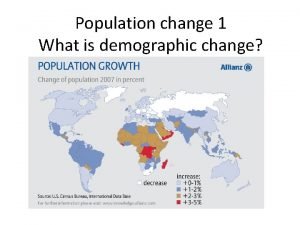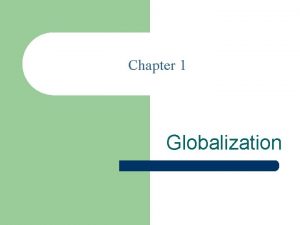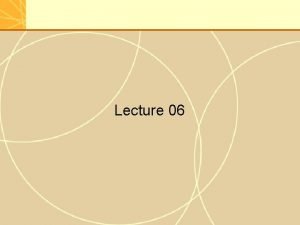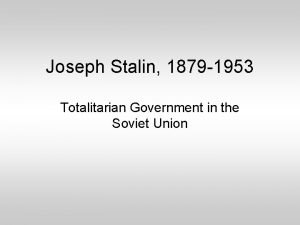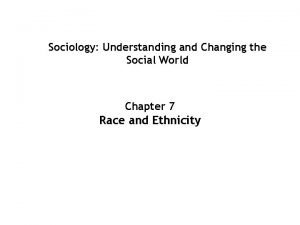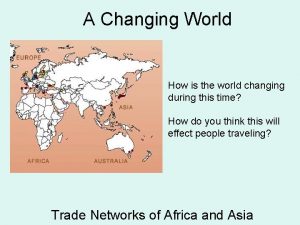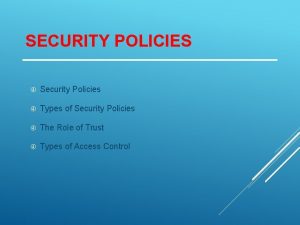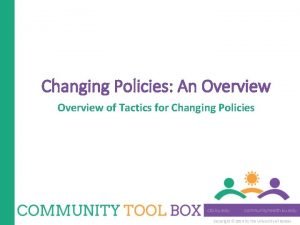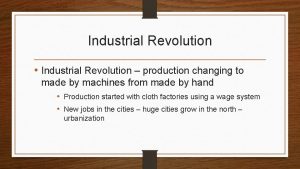Industrial Policies in a Changing World What Prospects













- Slides: 13

Industrial Policies in a Changing World What Prospects for Low-Income Countries? E 15 Second Expert Group Meeting Reinvigorating Manufacturing: New Industrial Policy and the Trade System Isabelle Ramdoo Deputy Head of Programme Trade and Economic Transformation Geneva, 4 -5 December 2014.

Structure of Presentation 1. Background 2. Industrial policies in LICs • What distinguishes LICs from other developing countries? • What has worked? Why and under what conditions? 3. Industrial and trade dynamics: What is changing? 4. What then for LICs? ECDPM Page 2

1. Background The Paper focuses on the specific case of low-income countries, zooming on some specific cases where targeted industrial policies have been used to promote specific economic sectors. In particular, the Paper looks at particular policies taken to address: Ø Market failures (pharmaceuticals in Bangladesh); Ø Economic diversification and productivity gaps notably through industrial upgrading (Ethiopia and cut flowers and RMG in Bangladesh) and; Ø Economic diversification (Mozal in Mozambique) ECDPM Page 3

2. Industrial policies in LICs: a. Key features to bear in mind 1. Domestic policy challenges: experience of industrial policy has generally been uneven and inconclusive due to: Ø Systemic factors: Cost of addressing market failure higher and ability of public sector to address these is more limited; Institutional/ governance weaknesses; poor private-public coordination; Ø Structural factors: Low-income, under-diversified, underindustrialized; significant productivity gaps; weak private sector; Significant weaknesses in hard and soft infrastructure and business/ investment climate; competitiveness is a major challenge although low labour cost is an advantage; access to finance ECDPM Page 4

2. “Policy space paradox” : • In the multilateral trading system, Policy space is NOT an issue: LICs have a lot of flexibility to undertake policy measures. Problem is how best to use such policy space; • But most often domestic policies are influenced by external pressures (eg conditional loans at IMF, WB; donor driven agenda etc) • LICs have rarely used up all available space to conduct industrial policies; Those who have, have never been challenged under the DS at WTO; • With increasing bilateral FTAs, they are themselves now constraining their policy space ECDPM Page 5

b. What has worked? Why and under what conditions? • In the specific case of LICs, the policy paradigm is still driven by the need to develop economic activities around labour/ resource intensive activities with the view of broadening the economic structure (incl for local consumption) and improving the competitiveness of exports. Why? Because industrial deficit large! • As such: objectives and focus of industrial policies and the need to overcome certain gaps/ constraints are somewhat guided that logic of “take off” and “catching up”. • Policies guided by (i) need to acquire industrial capabilities; (ii) move up the value chain; (iii) promote and develop new industries • Most popular policies remain (new forms of) ISI, EOI and RBI types of policies, although new global challenges imperatives certainly call for more innovation and technological-based policies ECDPM Page 6

Examples of ISI-types of policies 1. Bangladesh: Pharmaceutical sector (generic drugs) • • Primary objective (1982): Public health to address market failure preventing provision of affordable medicines for the poor; Host of measures to encourage local production and restrict imports of certain drugs by MNEs; Price regulations; Transfer of know-how and skills from foreign to local firms; Training of local cadres; Successful: covers 97% domestic demand & exports to 85 countries Overtime: some restrictive market conditions relaxed Key factors of success: • Policies framed in a way to limit rent capture (price caps & market control) • technological learning, transfer of know how and skills upgrading • TRIPS waiver for LDCs conferred production advantages Potential challenges: • Protection is not time bound; Expiry of TRIPS waiver in 2016 ECDPM Page 7

EOI-type of policies 1. • • • Cut flower in Ethiopia Incentives under export promotion strategy in four areas: Land acquisition: Govt-owned land leased at cheap rates; Low-interest rate long-term credit Subsidized key logistics (namely cargo space if using national carrier and post-harvest cold chains) Upgrading capabilities, through strategic partnership with Dutch government Key factors of success: • Targeted support through some sort of cluster approach (close to airport) • Government acted as a facilitator by removing key barriers • Subsidies contributed to cost advantage compared to regional rivals • Market access to EU DFQF due to EBA • Technological capabilities and partnership were key to attract and retain investment ECDPM Page 8

RBI type of policies 1. Aluminum smelting in Mozambique • RBI is quite specific: favourable resource endowment does not translate automatically into competitive advantage in RBI • Mozambique developed aluminum smelting without producing a single tonne of Bauxite (imported mainly from Australia). Objective economic diversification from agriculture • Yet, largest FDI in history of independent Mozambique Factors of success: • Political will! • Cheap inputs – essentially electricity and provision of logistical infrastructure (railways and port) • Fiscal and financial incentives • Strategic Joint venture combined with market factors (initially secured market for aluminum in Japan thanks to JV with Mitsubishi • ECDPM Is it really a success? ? ? Quite an enclave sector, little linkages created, limited employment Page 9

3. Industrial and trade dynamics: What’s changing? • Changing nature of industries (increasingly driven by global buyers and suppliers) and trade frameworks (proliferation of FTAs, in partic among big economies) pose additional challenges to LICs; Fragmentation of production structures led to (i) global dispersion of activities and (ii) shift of invt focus from country to value chain • Few are well integrated in GVCs; Those who are, are trapped at the lower-rung of the value ladder; • GVCs: Linking to GVCs require a different logic. Moving from industrial policies from the prism of government’s responsibility to diversify to one that focuses on firms and how to accompany them to remain competitive, upgrade and evolve? • Trade dynamics – has been discussed thoroughly but mega regionals will change the rules of the game and have significant impact on LICs ECDPM Page 10

4. What then for LICs? • How are LICs prepared to adopt this paradigm shift in the way they put forward industrial policies? Advantage of LICs : late comers (potential to leapfrog); disadvantage of LICs: late comers (getting more complicated) • Important to match policies against performance: some forms of support need to be time bound with clear sunset clause for ineffective ones • Not a question of policy space • Rather a question of: 1. policy scope: using existing policy breadth and depth in an effective and creative manner to broaden support and which are adapted to the new global challenges; 2. Policy mix: “hard” vs “soft”; “vertical” vs “horizontal” 3. Policy shift: trade policy is now dictating industrial policy, no longer the other way round. But in a smart way ECDPM Page 11

• The question of inclusiveness is important – if industrial development is driven by firms, then policies need to be guided by firms. Addressing coordination problems with private sector is key • LICs are not expected to be LICs forever: Ø Needs an adaptive strategy: how can policy evolve to move away from LICs ‘logic’ i. e from border restrictions to policies to build markets and capabilities Ø Needs different sets of logic that guide objectives and focus of industrial policies (eg. Policy space start to become real issues; less flexibility etc); ECDPM Page 12

Thank you www. ecdpm. org www. slideshare. net/ecdpm Page 13
 World population prospects
World population prospects The changing world output and world trade picture
The changing world output and world trade picture The changing world output and world trade picture
The changing world output and world trade picture Stalin's totalitarian state industrial policies
Stalin's totalitarian state industrial policies Elysian prospects
Elysian prospects Quantum computing progress and prospects
Quantum computing progress and prospects Prospects of agriculture in bangladesh
Prospects of agriculture in bangladesh Prospects preposition
Prospects preposition World changing glasgow
World changing glasgow English module grade 9 with answers
English module grade 9 with answers System analysis
System analysis Systems analysis and design in a changing world
Systems analysis and design in a changing world System analysis and design in a changing world
System analysis and design in a changing world Sociology understanding and changing the social world
Sociology understanding and changing the social world
